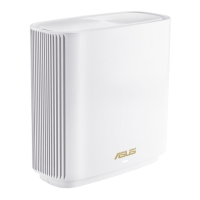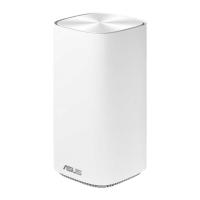Do you have a question about the Asus ZenWiFi XD4 Plus and is the answer not in the manual?
Lists the system requirements needed to set up the wireless network.
Instructions for setting up the ASUS wireless router via a wired connection.
Guides the user through quickly setting up the Internet connection using auto-detection.
Steps to connect a computer or smart device to the configured wireless network.
Instructions on how to access the router's web graphical user interface (GUI) for configuration.
Guides on configuring wireless network security settings like SSID and encryption.
Details how to set up bandwidth priority and manage network traffic using QoS.
Instructions for downloading and installing the latest firmware for the router.
Secures the network from exploits and unauthorized access by scanning and blocking threats.
Allows control over Internet access time and usage limits for network clients.
Configures the router as a hardware firewall to protect the network from attacks.
Enables temporary visitors to access the Internet via separate SSIDs without accessing the private network.
Configures the DHCP server to automatically assign IP addresses to network clients.
Configures various WAN connection types like PPPoE, PPTP, and static IP.
Directs network traffic from the Internet to specific ports or devices on the local network.
Configures basic wireless settings like SSID, security mode, and channel bandwidth.
Restores the router's firmware if it fails during an upgrade process.
Provides initial steps to resolve common router issues before seeking further solutions.
Troubleshooting steps for when the router's web GUI cannot be accessed.
Lists the system requirements needed to set up the wireless network.
Instructions for setting up the ASUS wireless router via a wired connection.
Guides the user through quickly setting up the Internet connection using auto-detection.
Steps to connect a computer or smart device to the configured wireless network.
Instructions on how to access the router's web graphical user interface (GUI) for configuration.
Guides on configuring wireless network security settings like SSID and encryption.
Details how to set up bandwidth priority and manage network traffic using QoS.
Instructions for downloading and installing the latest firmware for the router.
Secures the network from exploits and unauthorized access by scanning and blocking threats.
Allows control over Internet access time and usage limits for network clients.
Configures the router as a hardware firewall to protect the network from attacks.
Enables temporary visitors to access the Internet via separate SSIDs without accessing the private network.
Configures the DHCP server to automatically assign IP addresses to network clients.
Configures various WAN connection types like PPPoE, PPTP, and static IP.
Directs network traffic from the Internet to specific ports or devices on the local network.
Configures basic wireless settings like SSID, security mode, and channel bandwidth.
Restores the router's firmware if it fails during an upgrade process.
Provides initial steps to resolve common router issues before seeking further solutions.
Troubleshooting steps for when the router's web GUI cannot be accessed.
| Antenna type | Internal |
|---|---|
| Product type | Mesh router |
| Reset button | Yes |
| Product color | White |
| LED indicators | Power |
| Maximum coverage | 306.58 m² |
| Antennas quantity | 2 |
| Flash memory | 128 MB |
| Internal memory | 256 MB |
| Wi-Fi band | Dual-band (2.4 GHz / 5 GHz) |
| VPN support | VPN Client L2TP VPN Client OVPN VPN Client PPTP VPN Server IPSec VPN Server OVPN VPN Server PPTP |
| Wi-Fi standards | 802.11a, 802.11b, 802.11g, Wi-Fi 4 (802.11n), Wi-Fi 5 (802.11ac), Wi-Fi 6 (802.11ax) |
| Top Wi-Fi standard | Wi-Fi 6 (802.11ax) |
| Security algorithms | WPA, WPA2, WPA3 |
| Networking standards | IEEE 802.11a, IEEE 802.11ac, IEEE 802.11ax, IEEE 802.11b, IEEE 802.11g, IEEE 802.11n |
| WLAN data transfer rate (first band) | 574 Mbit/s |
| WLAN data transfer rate (second band) | 1201 Mbit/s |
| AC adapter frequency | 50 - 60 Hz |
| AC adapter input voltage | 110 - 240 V |
| AC adapter output current | 1.5 A |
| AC adapter output voltage | 12 V |











